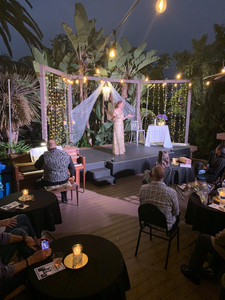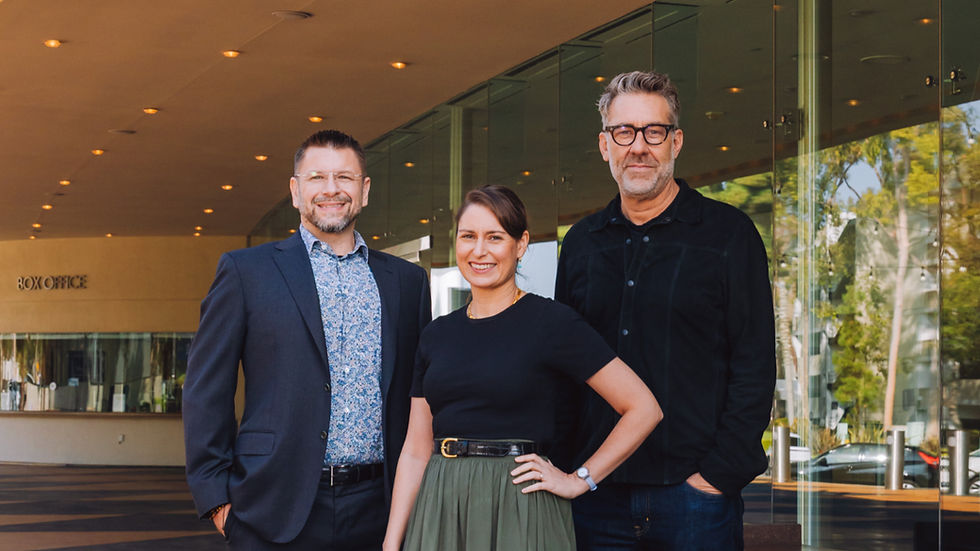Cabrillo Playhouse Catches a Second Wind
- Joel Beers

- Jan 22, 2024
- 7 min read

It’s a 71-year-old community theater inside a 95-year-old house located at the southernmost tip of Orange County, which has one of the highest percentages of older adult residents in the state.
But the Cabrillo Playhouse, Orange County’s second-oldest theater next to the Laguna Playhouse (which celebrated its 100th anniversary in 2020), isn’t living in the past. In a time when many theaters are still reeling from the pandemic both in terms of audiences and soaring inflation, the San Clemente theater over the past three years has added a second stage, embarked on a $200,000 renovation campaign and seen an infusion of younger faces in the audience and at auditions.
Credit for that goes to Michael Lopez, its producing artistic director in his ninth season, who believes that a community theater can nudge its community into new directions; an 11-person board of directors that has approved a couple of surprising program choices; and its core audience, which Lopez estimates averages around age 60, who didn’t raise a fuss when the drag queens, aspiring wizards and Transylvanian transvestites came to town.
But though the playhouse has its sights set on the future in terms of modernizing its facility and growing its audience, the past is very alive in one significant aspect: All this forward motion is happening because of a decision 58 years ago that made the playhouse one of the oddest theaters imaginable but also ensured it a degree of financial independence.
The Theater in a House
The Cabrillo Playhouse, as a performing space, was born in 1966. But the San Clemente Community Theatre as an entity was born 13 years earlier, when a San Clemente resident and former drama teacher named Thelma Rickman found some like-minded souls who thought the city should have its own theater.

It opened its first show, “Three Blind Mice,” on Sept. 14, 1953 at the Casino San Clemente. It then went on a 13-year tour of San Clemente and neighboring cities, performing in 10 venues before it found a permanent home. Thirteen years of doing theater but not paying rent paid off, as it was able to buy that home. It was, literally, a home: a 1928 white-walled, red-tiled roof house at 208 Avenida Cabrillo, one of the first constructed in the master-planned community that mandated all homes be built in the Spanish Colonial Revival style.
There aren’t many theaters – live theaters – built inside homes. One reason might be that unless the home in question was built for Louis XIV, few have rooms or a yard long or wide enough to accommodate much of a stage or seating area. This one didn’t, so an interior wall was removed, allowing for about 60 seats and a stage large enough to maybe cram a dozen bodies on stage.
That limits the kind of plays the playhouse can do; anything with large musical numbers, multiple set changes or elaborate set pieces is probably not going to happen.
There are lighting limitations as well due to the ceiling above the stage sloping from 10 feet above it at one end to 6 feet at the back. This makes entrances and exits for the height-challenged a bit problematic, and it also adversely affects the lighting.
There has been some work on the house since 1966, including a 1,400-square-foot addition that allowed it to expand its backstage, as well as the construction of an outside patio. But it would take a pandemic to finally address the stage issues.
These sets for "The Man of La Mancha" (photo 1) and the 2018 musical revue "The Best of Broadway" (photo 2) showcase the size and height limitations for shows produced at Cabrillo Playhouse. Photo courtesy of Cabrillo Playhouse/Michael Lopez
Pandemic Improvements
In 1978, its 25th anniversary, the Cabrillo Playhouse made its last mortgage payment, becoming a rarity in Orange County: It owns its own space.
Owning its own space “saved us during the pandemic,” Lopez said. “(Orange County) lost theaters during the pandemic and then with all the costs afterward, I don’t think we could have done it.”
The inactivity, however, during the pandemic wasn’t easy.
“I love theater, “ Lopez said. “I think I would go crazy without it. And I was going crazy during the pandemic.”
Faced with a theater he couldn’t use for who knows how long, Lopez decided to build another stage without knowing when it could be utilized. With board approval, he turned the outside patio into an actual performing space, the 44-seat Garden Cabaret stage, which opened in August 2021.
It was the original outdoor patio but now with lights and a small but legit stage, ideal for music reviews and intimate shows like “Love Letters” – A.R. Gurney’s Pulitzer Prize-finalist 1988 play in which two characters read letters they have written to each other over the course of a 50-year relationship – but also versatile enough to handle Shakespeare.
Plus, it looks kind of special, Lopez said.
The Garden Stage opened in August 2021. Emily Price (photo 1) and Melinda Messenger Stout (photo 2) perform for an audience seating area that accommodates 42-chairs. Photos courtesy of Cabrillo Playhouse/Michael Lopez
“When you do a show out here at night during the summer, and it's beautiful weather, and we have candles on the tables, and people can get a bottle of wine and bring it to their table. It's pretty magical.”
The pandemic had one other positive impact: a $50,000 grant the playhouse is using at the starting point for a $200,000 “Raise the Roof” campaign that will make the ceiling above the stage a uniform 10 feet height, as well as pay for new furnishings and paint and an overall makeover for the house with the theater inside it.
Leading its Community
The Cabrillo Playhouse is a community theater in that it relies almost solely on ticket sales and donations from its community, does not pay its actors (besides a $100 stipend), and relies heavily on volunteers.
With the vast majority of its audience and financial support coming from the community it’s embedded in, the theater’s programming needs to appeal to that community. What Lopez has discovered about his is that dramas don’t do well, but comedies and murder mysteries with a touch of humor do, as well as musicals.
And they have to be familiar shows that better watch their mouths.
“If they’re not familiar, people won’t come and actors won’t audition,” he said. “And no foul language. We get more complaints for that than anything.”
But Lopez, who spent 25 years as a professional dancer and choreographer before joining the playhouse, knows that for any theater to have a future it needs to attract younger audiences. That means finding plays that appeal to younger people, but don’t drive older people away. That’s a delicate balancing act, Lopez said, but he thinks it is a theater’s responsibility sometimes to lead its community into places it otherwise might not go.
But knowing how far an audience can go is a risky proposition. In 2018, Lopez decided to gamble.
He booked a three-night run during the summer: a musical revue called “Queens of the Kingdom.” The members were all Disneyland employees who also performed as a drag queen ensemble. The board approved it and the show sold out with no complaints.
Lopez booked the act for the next summer. Its success also made him think perhaps it was time for an even bolder step. A member of the ensemble had put together a troupe that did the “Rocky Horror Show,” a staged production based on the film, “The Rocky Horror Picture Show.” The live show not only kept the interaction the movie was long known for, it accelerated it and had become a staple at theaters across the country. It was fun and familiar.
But it was also highly suggestive and sexualized and centers on a couple of clean-cut Americans who are seduced and brainwashed into sexual liberation by a mad scientist who is also a transvestite.
Lopez wasn’t sure how the show would land with the playhouse’s regulars. But first, he had to see how the board would react.
“I had no idea what would happen,” Lopez said he told the board. “If it would sell. But I also said that I thought we really needed to do something to bring in a younger audience. And they approved it. And it sold like crazy.”
There were new faces in the audience, but there were also regular faces, Lopez said.
“Rocky Horror” was booked for the following summer. Then the pandemic arrived, but when audiences could return to the Cabrillo in summer 2021, it was the first full production that greeted them. And it’s been back every year since.
“It’s become a tradition,” Lopez said.
Since the pandemic, the playhouse has also staged a world premiere musical based on Mary Shelly’s novel, “Frankenstein,” written by Elliott Jones, a Santa Ana College professor, and mounted the Orange County premiere of “Puffs,” an affectionate parody of the Harry Potter universe. Again, both are familiar properties but different takes that brought in younger faces while not driving away the older core.
“‘Rocky Horror’ has been the show for the Cabrillo that has consistently brought the most new patrons into our space,” said Hillary Pearson, who joined the Cabrillo’s board in 2021. “But another show that brought in new crowds was the new musical ‘Frankenstein,’ Most shows were sold out and we had many new-to-the-theater ticket buyers.”
“Rocky Horror” will be produced this summer, so it’s not part of the playhouse’s regular subscription series. But when you look at the next three plays on tap at the playhouse, the perceived distance in programming that many think is what truly separates a professional theater from a community theater gets a little blurry.
On Jan. 19, “A Comedy of Tenors,” by Ken Ludwig opens. Ludwig has cracked the top 10 list of most-produced playwrights at professional theater groups every year since 2015.
In March it’s the Hitchcock send-up “The 39 Steps,” which was part of South Coast Repertory’s pandemic-erased 2020-21 season.
Then comes Stephen Sondheim’s “Sweeney Todd,” which is currently playing on Broadway, and will be at the Segerstrom Center in June and the Chance Theater in July.
With its finances fairly secure and a board that Lopez says he feels gives him “100 percent support” in programming decisions, the future for this 71-year-old theater seems secure. Pearson, who joined the board in 2021 after directing 30 shows for Anaheim’s Tri-School Theatre (the theater program encompassing Connelly, Rosary and Servite high schools), said future security is bolstered by the amount of passion exhibited by everyone involved with the playhouse and other local theaters she has seen.
“I have time and time again seen and heard audience members leaving the theaters and marveling at the quality of the show, be it a play or a musical,” Pearson said. “ And I believe that is due to a combination of the talents and the passion they are seeing up on these stages. There are remarkable things being done on small, local stages across the county.”













.png)







.png)

.png)
